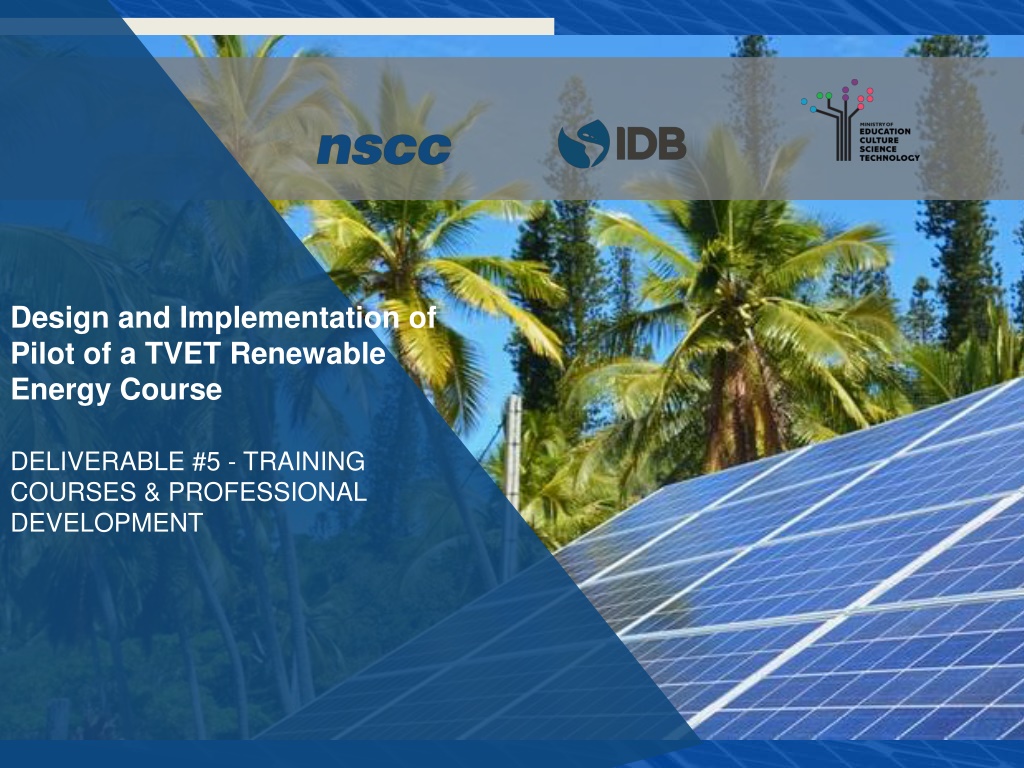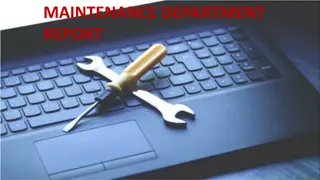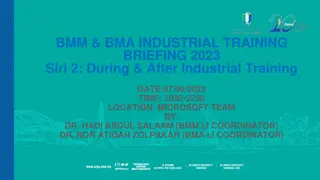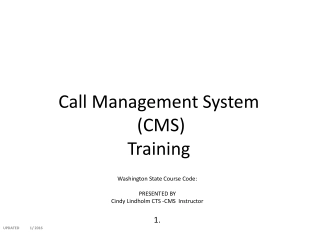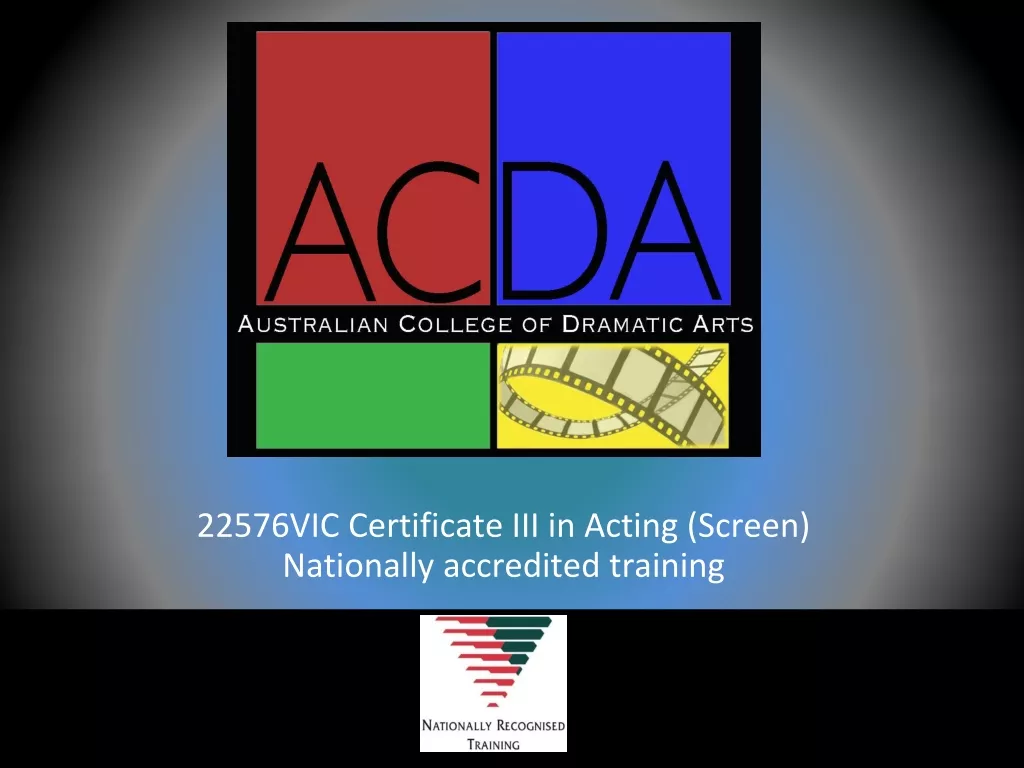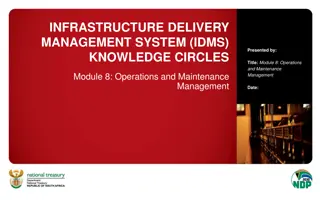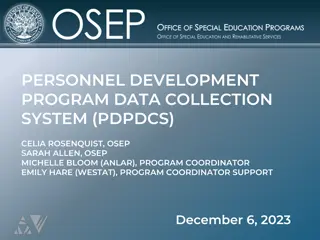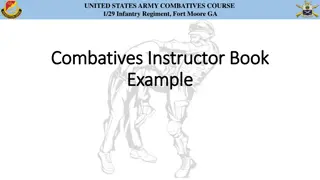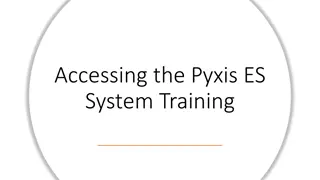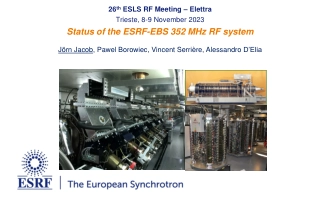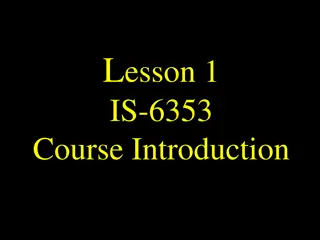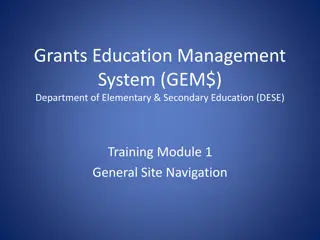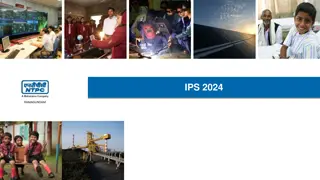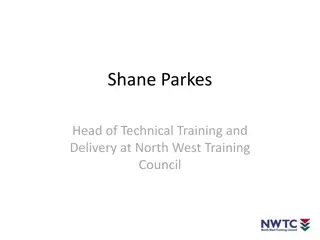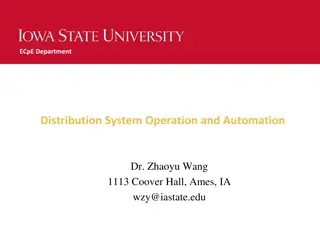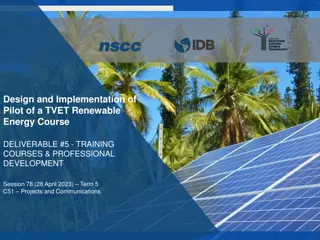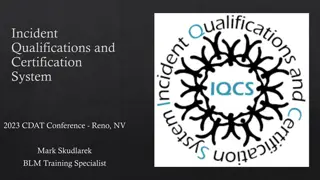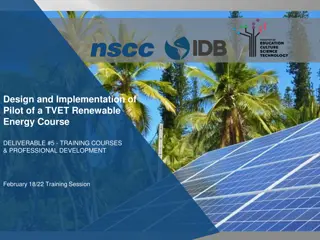PV System Maintenance Training Course Overview
This training course focuses on the operation and maintenance of Photovoltaic (PV) systems, covering topics such as component performance evaluation, reading manufacturers' data sheets, troubleshooting techniques, and safe reading practices. The course explores three main types of maintenance - corrective, preventative, and predictive - emphasizing safety requirements, including proper planning, lockout/tagout procedures, and the use of personal protective equipment during PV system servicing.
Download Presentation
Please find below an Image/Link to download the presentation.
The content on the website is provided AS IS for your information and personal use only. It may not be sold, licensed, or shared on other websites without obtaining consent from the author. Download presentation by click this link. If you encounter any issues during the download, it is possible that the publisher has removed the file from their server.
Presentation Transcript
Design and Implementation of Pilot of a TVET Renewable Energy Course DELIVERABLE #5 - TRAINING COURSES & PROFESSIONAL DEVELOPMENT
Maintenance PV System Operation and Maintenance Course Outcomes. Determine the performance of each component in a PV system. Read and interpret manufactures data sheets for scheduled maintenance. Demonstrate trouble shooting techniques on PV systems. Demonstrate how to take readings safely from PV systems.
Maintenance What is maintenance? There are three basic types of maintenance. Corrective Preventative Predictive
Maintenance Corrective maintenance is what you need to do when something fails. Call it repairing or troubleshooting. When a part of the system has either stopped working properly or has failed, it is necessary to do corrective maintenance.
Maintenance Preventative Maintenance attempts to spread out the maintenance activities by planning on a regular basis. Equipment is regularly inspected, cleaned and have adjustments made to them by maintenance workers. Since the maintenance is done on a schedule, equipment will be addressed at a specific time, not when some type of event occurs.
Maintenance Predictive maintenance attempts to forecast when a piece of equipment is going to fail or stop performing as expected. This is done by monitoring the equipment and then using the data that is collected (during maintenance or online) to prevent the failure before it occurs. Instead of working on a schedule, maintenance is driven by indications given by the equipment.
Maintenance Safety Requirements The first thing this course will examine are safety related topics. Whether the work is performed alone or as a team some basic rules need to be established. The scope of the work needs to be identified.
Maintenance Safety begins with adequate planning and preparation. Safety requirements during PV servicing include the proper use of lockout / tagout procedures. Utilizing personal protective equipment (PPE). Safe work procedures for safely disconnecting live circuits.
Maintenance When performing work around these systems there normally is a work order. It is a document that provides all the information about a maintenance / troubleshooting task and outlines a process for completing that task. It may include details on who authorized the job, the scope, who it's assigned to, and what is expected. A written document that has this shall be used.
Maintenance Lockout / tagout is required when energized equipment is serviced or maintained. Required if safety guards are removed or bypassed. If a worker has to place any part of their body in the equipment s point of operation, or if hazardous energy sources are present. It is assumed that lockout / tagout was covered in previous safety courses.
Maintenance Selecting the PPE and having it on site will help minimize exposure to site conditions and equipment hazards. Site assessment to identify potential hazards is part of the process to selecting the appropriate PPE for the maintenance task at hand. Competency in the classroom must be observed before maintenance can be performed on PV direct current (dc) circuits.
Maintenance The competency will be developed through performing lab exercises during this course. Taking live dc readings (voltage and current) can be dangerous. Competency must be demonstrated on this work. The operation of disconnection means and work around combiner boxes and junction boxes will be part of lab work during the course.
Maintenance DC voltages up to 1000 V will become common. This course will not prepare learners to work on voltages above 4 modules connected in series. Arc flash requirements will be a concern and it will be more common to see arc flash warning labels on combiner boxes and disconnects. Another competency is the ability to understand how to calculate the DC voltages present before performing maintenance.
Maintenance Missing signage is very possible on systems. When preparing for a maintenance operation at a jobsite besides PPE an appropriate fire extinguisher and first aid kit shall be on hand. Personnel must have proper training in their use.
Maintenance Isolating live DC circuits is a dangerous operation. One can not assume that disconnect switches are grounded and operate correctly. The minimum PPE to operate the disconnect is safety glasses and gloves.
Maintenance There is a Left Hand Rule for operating disconnects. Hold the disconnect with your LEFT hand Turn your body to face away from the switch. Close your eyes. Take a deep breathe and hold it. Then "throw" the disconnect lever. Using this method reduces the risk of injury if an arc flash does occur.
Maintenance Afterwards use a properly rated voltmeter to confirm that no voltage is present on the disconnected circuit. If possible, visually inspect that the operating blades have moved to the open position. A common failure, is one of the blades are welded shut or the linkage fails to open a blade.
Maintenance One blade stays shut because the linkage failed. Weak linkage or welded shut blade. Courtesy Linked In
Maintenance Routine Scheduled Preventive Maintenance When a person arrives at the jobsite, a site assessment to the physical surroundings is observed. What are the site hazards? They can include physical hazards and energy hazards. These hazards need to be identified and documented.
Maintenance Physical hazards can include: Clutter, garbage, or other material. Working from heights. Machinery Hot surfaces Animals
Maintenance Energy hazards can include: Battery / chemical. Sufficient current to burn or arc. Voltage sources to electrocute or arc flash. Rotational machinery. Wind, solar, hydro or pressures stored in a device.
Maintenance First is step being to identify what and where are the sources of energy? Can you determine those dangers without a system drawing? Does there need to be a written procedure developed to deal with them?
Maintenance To prevent and safeguard against these hazards the preferred order of action based on overall effectiveness would be: 1. Elimination 2. Substitution 3. Engineering controls 4. Administrative controls 5. Personal protective equipment (PPE)
Maintenance Elimination Can those dangers be removed? By releasing any stored energy. By isolating the energy. Solar PV panels can be covered with opaque material.
Maintenance Substitution Can the work be performed at night? Can the energy be replaced with a safer source? Power Supply as an example.
Maintenance Engineering controls reduce and try to prevent hazards from coming into contact with workers. Engineering controls can include modifying equipment or the workspace, using protective barriers, ventilation, and more. Prevent users from modifying or interfering with the control.
Maintenance Administrative controls use work practices to reduce the duration, frequency, or intensity of exposure to hazards. This may include: Lockout tagout procedures. Work process training. Ensuring adequate rest breaks. Limiting access to hazardous areas.
Maintenance Personal protective equipment (PPE) PPE is equipment worn to minimize exposure to hazards. Examples of PPE include: Gloves, safety glasses, hearing protection, footwear, hard hats, and aprons.
Maintenance Knowledge is the most important component of safety. Developing safety procedures is required on PV systems. Operating, troubleshooting and maintenance procedures are part of this safety procedure. Consult manufacturers manuals for equipment level procedures.
Maintenance Before performing any work, this procedure must be documented and designed. Safe work practices Written methods outlining how to perform a task with minimum risk to people, equipment, materials, environment, and processes. Safe work procedures A series of specific steps that guide a worker through a task from start to finish in chronological order.
Maintenance This topic should have been introduced in previous courses. Safe Work Procedures include: Description of work Scope Authorizations and/or pre-requisites
Maintenance Potential hazards Safety controls Personal Protective Equipment (PPE) requirements Responsibilities of each employee/contractor involved Instructions or a fixed sequence of steps to follow
Maintenance Clean up / shut down procedures Emergency / evacuation procedures Any additional information that needs noting
Maintenance The basic types of PV maintenance for this course will be the following: General Site Inspection Grounding and Racking Inspection Wiring and Combiner and Junction Box Inspection Utilization Equipment Inspection
Maintenance Personnel responsible for system maintenance should always review the system manuals prior to deploying to the site if possible. They should ensure that all maintenance parts and required tools are available for any on-site visits. Various spare parts should be on hand.
Maintenance General Site Inspection Upon arrival conduct a general inspection of the PV installation site. Is working from heights a consideration? If previous knowledge of site required scaffolding and ladders, they should be either on site or arranged to be there. Fall arrest PPE needs to be used.
Maintenance Upon arrival conduct a general inspection of the PV installation site. Look for obvious shading. Is this shading part of the maintenance procedure? New growth or was it always there?
Maintenance Check the tilt and orientation of the array. Is it part of the maintenance procedure? Has the tilt or orientation changed?
Maintenance Check to ensure roof penetrations are watertight, if applicable. Check and ensure roof drainage. Are the roof drains clogged? Could they now be part of the maintenance. Check for signs of water pooling in the vicinity of the array.
Maintenance Check for vegetation growth or other shade items that will affect the performance of the array. Is ground erosion near the base / footings of a ground mount array evident. Is there signs of animal / bird infestation under or on the array. Check for debris from under or around the array, can it be removed?
Maintenance Although not an issue yet, take the time to remove the growing vegetation. Cory Manuel
Maintenance The General Site Assessment form can be the following.
Maintenance The electronic version of this form is part of the documentation for the course.
Maintenance Array Maintenance The next section involves maintenance for the PV array and associated racking, cabling and equipment that pertains to the PV system.
Maintenance These next slides describe the procedure before working with the array. There is no assumption that it is safe to touch the array. The metal components need to be checked for bonding to earth.
Maintenance Before going to the worksite are there any drawings / sketches for the system? Upon entering the worksite and completing the General Site Assessment, the PV array is noted for its type of mounting and location. A visual check is made and take notes. Are safety signs and labels in place?
Maintenance Do not touch any metal parts until after the equipment grounding is inspected. Is the array ( can be just one panel) in a readily accessible location? Working from heights consideration? Disconnection means accessible? Racking issues that are visible?
Maintenance Does the racking need to be repaired when first looked at? Take notes on accessibility, and any physical damage that is visible. Ladder or scaffolding required? Is the mounting structure safe to access?
